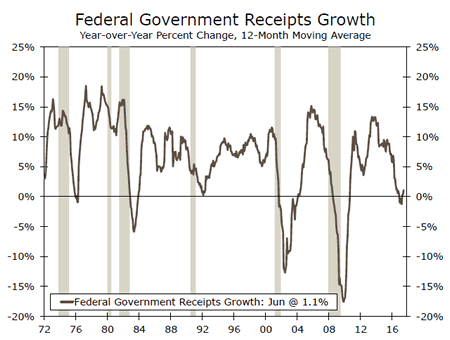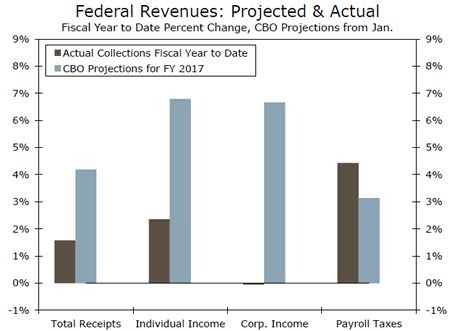U.S. Review
Inflation Soft & Housing Starts Solid in Quiet Week
- A strong print for housing starts in June was the most noteworthy piece of economic news in an otherwise quiet data week. Starts jumped 8.3 percent, while building permits also rose a healthy 7.4 percent.
- Import price inflation was subdued in June, although excluding petroleum, prices eked out a gain.
- The Leading Economic Index surged 0.6 percent in June, the largest increase since December 2014. Initial jobless claims matched the second-lowest reading of the expansion this past week, another encouraging sign for economic growth in H2.
Inflation Soft & Housing Starts Solid in Quiet Week
A strong print for housing starts in June was the most noteworthy piece of economic news in an otherwise quiet data week. Housing starts rose 8.3 percent to a 1.215 million-unit pace in June following three months of declines (see chart on front page). Permits for future construction also increased, climbing 7.4 percent. Starts were up for both single- and multifamily. Multifamily starts were particularly strong, with construction bouncing back to a 13.3 percent month-over-month pace. Activity was up sharply in the Midwest and Northeast but fell in the South, which has seen an onslaught of new apartment supply. At the midway point of the year, single-family starts accounted for the entirety of the six percent gain in total housing starts, with single-family rising a steady 10.7 percent year to date.
The import price index release for June was the last inflation reading before next week’s FOMC meeting, and it did little to assuage fears about the recent slowdown in inflation. Total import prices declined 0.2 percent in June. Prices for imported petroleum fell for the fourth consecutive month, declining 2.2 percent. On a year-over-year basis, import prices moderated to a 1.5 percent pace, down from the recent cycle high of 4.6 percent in February. Ex-fuel, import prices eked out a 0.1 percent gain. Nonfuel import price growth has stalled on a year-ago basis, but expectations for a weakening U.S. dollar should pressure non-fuel import prices higher (top chart). This should be supportive to the Fed’s goal of getting inflation up to two percent as policymakers grapple with the recent deceleration in prices.
The Leading Economic Index (LEI) surged 0.6 percent in June, the largest monthly increase since December 2014 and a promising sign for economic growth in the second half. The jump in building permits added 0.21 percentage points to the topline figure, and the strong June reading from the ISM manufacturing new orders component also provided a boost. The LEI is a key input into our preferred recession forecasting model, which produces the probability of a recession in the next six months. The LEI has had a solid run of late, rising at a 5.0 percent annualized rate over the past six months (middle chart). This string of healthy readings has helped push the probability of a recession in the next six months down to low levels.
Initial jobless claims was the sole negative contributor to the June LEI, but claims fell to 233,000 in the week of July 15, matching the second-lowest reading of the expansion. Initial jobless claims continue to show few signs of distress in the labor market, and the downward trend has been remarkably steady; the 52-week moving average is currently at the lowest level since 1974. This fact is yet another unusual aspect of today’s labor market that complicates monetary policy decision making. The number of people joining the unemployment rolls is near historical lows, yet the number of long-term unemployed is historically high for this point in the cycle (bottom chart). More than eight years of steady recovery from the Great Recession and the economic scars still show.
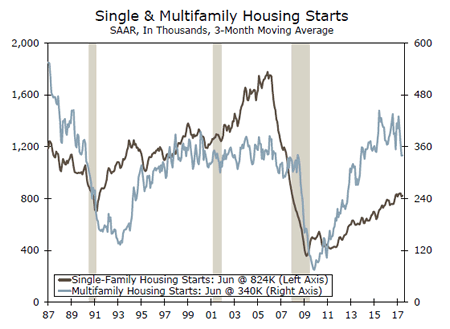
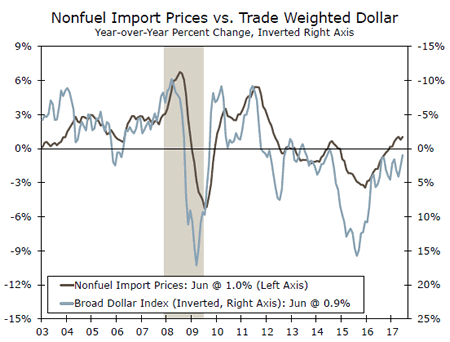
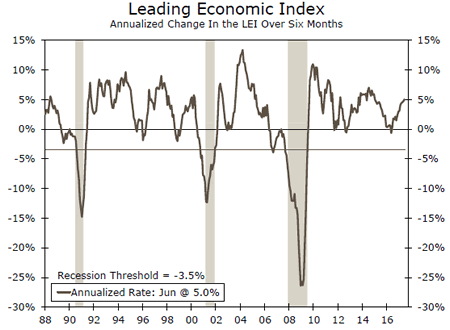
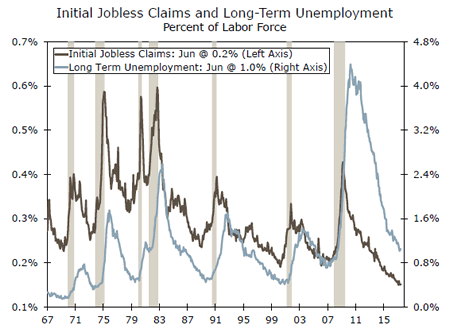
U.S. Outlook
Existing Home Sales • Monday
Resales rose 1.3 percent in May to a 5.62 million annualized pace. Sales of existing homes are restrained by unusually lean inventories of homes for sale, which has made for a very competitive market for would-be homebuyers across much of the country. The typical home was on the market for just 27 days before being sold in May. Tight inventories have boosted the median selling price to a record $252,800 in May.
Tight inventory also weighed on pending home sales in May, which is a good predictor for June existing sales. Pending sales were down 0.8 percent in May, its third consecutive drop. Demand for homes is solid, boosted by rising incomes and job prospects, though supply is likely to remain a limiting factor. The competitive market and rising prices are likely to continue for some time, but strong demand fundamentals will continue to encourage more home building.
Previous: 5.62M Wells Fargo: 5.60M Consensus: 5.56M
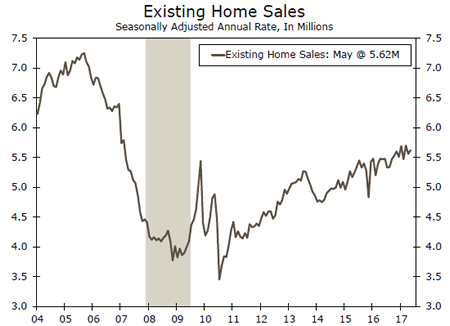
Consumer Confidence • Tuesday
The Conference Board’s overall measure of consumer confidence rose 1.3 points in June to 118.9, as consumers’ upbeat assessment of the present situation offset declining expectations for the future. Improvement in the job market was a key factor in consumers’ positive present attitude. The diminishing lift from the expectations component likely reflects increasing skepticism of major progress toward the new administration’s policy objectives, at least as soon as some had hoped.
The preliminary figures from the University of Michigan’s survey of consumer sentiment showed diminishing expectations continued in July, but consumers were still pleased with the current economy. Final numbers for that survey are also released next week. Consumers’ expectations influence spending more than confidence in the present situation.
Previous: 118.9 Wells Fargo: 117.0 Consensus: 116.0
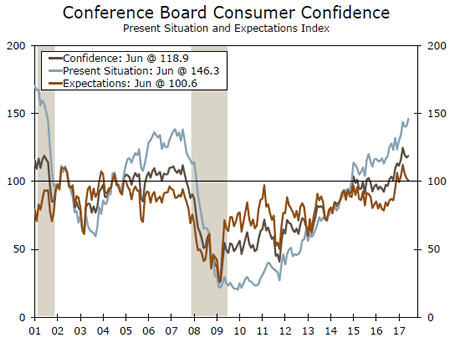
GDP • Friday
Our call for Q2 GDP growth is 2.2 percent, as our expectations remain more muted than the consensus forecast. We continue to expect a stronger print than the first quarter, particularly for the personal consumption component, which we expect will increase 3.3 percent in Q2 after a paltry 1.1 percent in Q1. Our call has a lift from both residential and business fixed investment in Q2, albeit smaller than that of Q1. We also expect the change in inventory investment to add to growth in Q2 after a large contraction in Q1, while net exports also reverses direction, cutting into Q2 growth. Government spending is likely to remain a drag in Q2.
We see little reason to expect economic growth to ramp up significantly through the end of the year, and remain confident real GDP will grow between 2.0-2.5 percent in 2017. Without a major ramp up in productivity growth, the U.S. economy is unlikely to stray from its current course.
Previous: 1.4% Wells Fargo: 2.2% Consensus: 2.5% (Quarter-over-Quarter, Annualized)
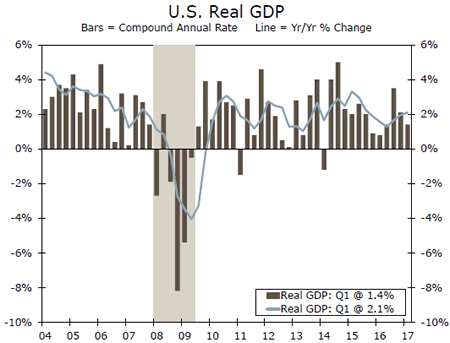
Global Review
Good Data on the Economy; Weak Data on Inflation
- The week started with a slightly better-than-expected result for the Chinese economy in the second quarter, with growth topping expectations at 6.9 percent over a year earlier and matching the rate of growth of the first quarter of the year.
- As expected, the ECB kept its policy stance without change but Mario Draghi, the ECB president, sounded a bit more dovish than what markets have been expecting as the monetary institution gets closer to what should be the start of a tightening process.
Good Data on the Economy & Weak Data on Inflation
The week started with a slightly better-than-expected result for the Chinese economy in the second quarter with growth topping expectations at 6.9 percent over a year earlier and matching the rate of growth of the first quarter of the year. We also saw a better-than-expected retail sales index for June, up 11.0 percent versus expectations for a 10.6 percent increase, and besting the previous months’ print of 10.7 percent. Meanwhile, industrial production for June was also a bit better than expected, up 7.6 percent, year over year, versus expectations of a 6.5 percent increase. Year to date, industrial production was up 6.9 percent versus expectations of a 6.7 percent increase. Thus, GDP, retail sales and industrial production in China are indicating that the Chinese economy ended the second quarter on a positive note.
However, data from the Eurozone were mixed with the Zew expectations survey for July coming a bit weaker than in June, at 35.6 versus 37.7. Similarly, in Germany, the Zew expectations index was lower than expectations as well as lower than the June reading, at 17.5 versus 18.6 in June. Meanwhile, the German Zew current situation index was 86.4 versus 88.0 in June. Markets were also expecting the current situation index to remain at 88.0 in July.
Meanwhile and as expected, the ECB kept its policy stance without change but Mario Draghi, the ECB president, sounded a bit more dovish than what markets have been expecting as the monetary institution gets closer to what should be the start of a tightening process. However, the biggest issue today is that inflation is showing no upward momentum, in Europe or the United States, even in the face of an improving economic outlook in the former, which puts the reflation story in jeopardy and can change the timing of a starting date for the tightening process.
In the U.K. retail sales were stronger than expected in June, up 0.6 percent, partially reversing May’s 1.1 percent decline. Excluding auto fuel, retail sales were stronger, up 0.9 percent but also only partially reversing the 1.5 percent decline recorded in May. However, analysts pointed to the fact that June was the warmest month since 1976, pushing people "to buy more clothing and thus helping to offset declines in food and fuel."
Recent economic weakness is also slowing down price pressures in the U.K. economy. CPI inflation was flat in June and lower than markets expectations of a 0.2 print. June’s print pushed down the year-over-year rate from 2.9 percent to 2.6 percent while the core rate was down from 2.6 percent to 2.4 percent. This was likely music to the ears of the majority of the Monetary Policy Committee members who were expecting lower inflation numbers and were not convinced of the need to raise interest rates.
In Japan, June exports grew at a stronger-than-expected rate of 9.7 percent year over year. However, they slowed down from a 14.9 percent year-over-year rate recorded in May. Imports also grew at a better-than-expected rate, up 15.5 percent, but were also weaker than the 17.8 percent year-on-year rate reported in May.
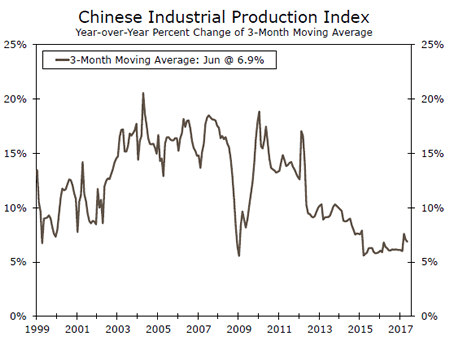
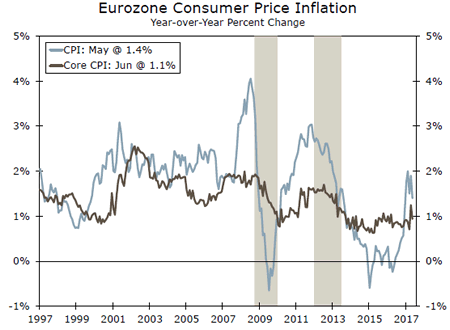
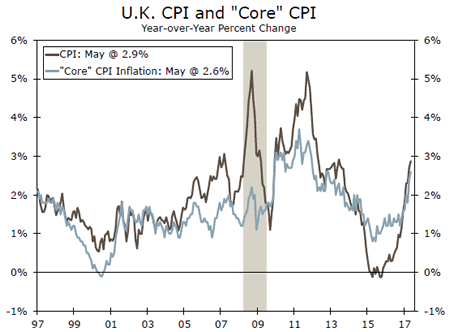
Global Outlook
Eurozone PMIs • Monday
ECB President Draghi made reference this week to the "robust recovery" going on in the Eurozone. For financial markets that were expecting dovish undertones out the ECB, the more neutral assessment of the Eurozone’s economy spooked the stock market.
When bourses open on Monday of next week in Europe, investors will get the pulse of business activity for July when the preliminary survey results for manufacturing and services. While the PMIs have been in expansion territory for the past four years, only recently have they broken north of 55. This represents the fastest pace of expansion since the relief rally in 2011, which followed the European sovereign debt crisis of a year earlier.
In the latest print, the manufacturing PMI rose while the service sector gave up some ground. No major change is expected, which suggests any change we do get could be market moving.
Previous: Manufacturing: 57.4 Services: 55.4 Consensus: Manufacturing: 57.2 Services: 55.4
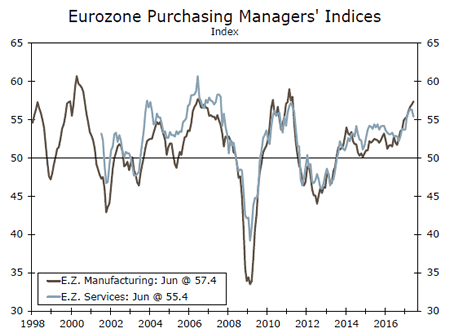
U.K. GDP • Wednesday
Recent meetings of the Bank of England’s Monetary Policy Committee have shown growing dissent over keeping rates unchanged with some members calling for rate increases. The shift to a more hawkish bias was one of a number of factors driving British pound sterling higher over the past few months.
The momentum toward an eventual rate hike was dealt a setback this week when the June CPI report showed virtually no inflation in the month-over-month rate for June. The year-over-year rate remains high at 2.6 percent, but that is slower than the 2.9 percent annual rate reported in the prior month.
On Wednesday of next week, financial markets in the United Kingdom will be focused on Wednesday’s initial estimate for second quarter GDP growth. After a 0.2 percent increase in the first quarter, markets are looking for 0.3 percent in the second.
Previous: 0.2% Wells Fargo: 0.3% Consensus: 0.3% (Not Annualized)
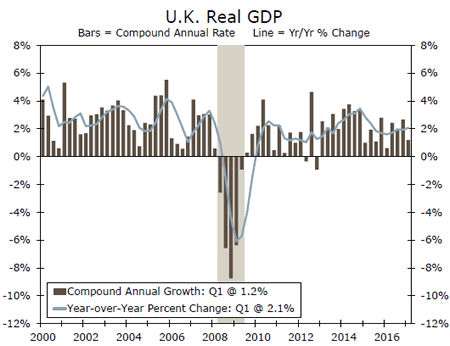
Japanese CPI • Friday
The Fed and the Bank of Canada are raising rates, and most of the world’s major central banks have at least begun to talk about policy normalization, but the Bank of Japan (BoJ) has been the holdout. At its policy meeting this week, the BoJ maintained its comprehensive program of policy easing with no clear end in sight.
As the nearby chart shows, the CPI inflation backdrop justifies the BoJ’s accommodative stance. Aside from a brief spurt in reaction to the 2014 consumption tax, sustained CPI inflation north of 2.0 percent has not been achieved since the early 1990s.
The June CPI report is due out on Friday of next week. The headline rate is not expected to be much different from the 0.4 percent rate posted in May. The BoJ has talked about the need to overshoot its 2.0 percent target before dialing back monetary policy support.
Previous: 0.4% Wells Fargo: 0.4% Consensus: 0.4% (Year-over-Year)
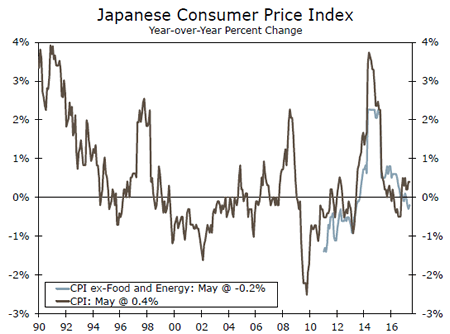
Point of View
Interest Rate Watch
Cautiously Resolute
There was little in the way of economic news to sway the policymakers one way or the other just ahead of the July 25-26 FOMC meeting. While no major policy moves are expected at that meeting the language in the policy statement will likely acknowledge that labor market conditions have strengthened further and inflation remains on the low side of expectations. Financial conditions have also eased since the last FOMC meeting, with equity prices rising and bond yields falling. The policy statement will also likely provide some indication that the Fed is closer to formally announcing when and how it plans to begin to reduce its balance sheet. We expect a formal announcement in September.
Fed Chair Yellen and many other FOMC members remain resolute in their faith that the recent soft inflation data are transitory. The pullback in inflation on a year-ago basis is largely due to a series of one-0ff factors, including lower cell phone service prices and lower health care costs. Rents are now also decelerating, as a surge of new apartments is being delivered to many of the markets that had seen sharp rent increases. Lower oil prices are also helping hold down transportation and utility costs.
The bond market does not appear to share the Fed’s conviction that today’s lower inflation will prove transitory. The bond market’s doubts are backed up with seven years where inflation has largely remained below the Fed’s expectations. And inflation is also lower around the world. Bond yields declined this week, and the financial markets are increasingly buying into the notion the Fed is close to being done hiking rates for this cycle. We do not share this conclusion and continue to see the terminal federal funds rate well above two percent. The Fed is only half way there.
In addition to the FOMC meeting, second quarter GDP is released next Friday along with revisions for the past three years. The annual revisions are one reason why there is such a wide range of estimates for second quarter growth. Beyond that, the markets can look ahead to the July jobs data, which based on the most recent claims figures, should once again come in hot.
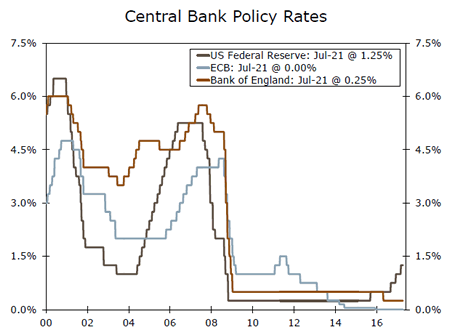
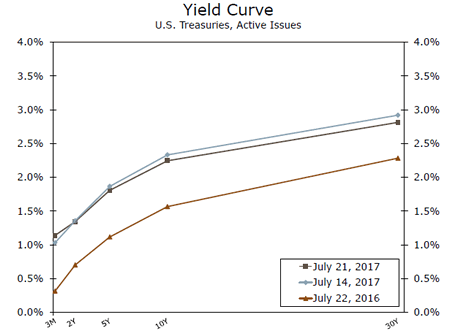
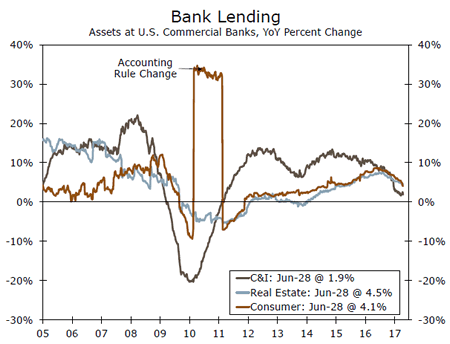
Credit Market Insights
Sentiment for Credit Access Rises
The Federal Reserve Bank of New York released its Credit Access Survey on Monday. The survey breaks down loan application and rejection rates for loan categories over the past four months, such as auto, mortgage and credit card, and segments the data into demographics and credit score categories. The survey showed the share of discouraged applicants with low credit scores reached a record low in June, suggesting the overall pool of applicants is more optimistic about the potential to receive approval.
Indeed, the discouraged proportion of potential credit seekers with credit scores below 680 fell to just 14.6 percent. Despite this, individuals from that credit range who submitted applications saw a rejection rate of 37.8 percent over the past four months, up 8 percentage points since February.
No credit type reflects this trend more than mortgage refinancing loans, which saw a 2 percent decrease in total applications, but a staggering 10.4 percent increase in the rejection rate. Total applications increased only in those same low credit score applicants. It is possible that the recent rate hike by the Fed, as well as similar hawkish sentiments coming from other central banks, might have pushed those applicants to refinance mortgages while interest rates remain low. Our projections indicate a modest rise in interest rates over the next year, which should not have a major effect on the supply of credit.
Topic of the Week
A Warning Sign from Federal Tax Revenues?
Federal tax revenues have sharply decelerated, leading some commentators to draw attention to this potential red flag. Admittedly, the current pace of federal revenue growth is more in line with recessionary periods than with healthy expansions (top chart). As recently as January, the Congressional Budget Office projected total federal revenue growth in FY 2017 would be 4.2 percent and individual income tax collections would grow a healthy 6.8 percent. However, with three-quarters of the fiscal year complete, federal receipts growth has been just 1.6 percent for total revenue and 2.4 percent for individual income tax receipts.
We believe that fears regarding this indicator are overblown. The prospect for tax cuts in the wake of the presidential election likely led investors to delay realizing capital gains at the end of 2016, hoping to instead realize the gains in 2017. The net investment income tax imposed by the Affordable Care Act has been on the chopping block all year, and the House Republican tax plan calls for a top capital gains tax rate more in line with the rate seen after the Bush tax cuts.
We have data for two subsets of tax receipts that provide evidence for our case: income taxes withheld from workers’ paychecks and payroll taxes. These data are less volatile sources of federal revenues, proxy employment and income growth and comprise the bulk of federal tax receipts. Payroll taxes are the only category running ahead of the CBO’s projections fiscal year to date (bottom chart). Similarly, withheld income tax receipt growth has slowed, but at a more modest pace that is consistent with the gradual deceleration in employment over the past couple years. When viewed through this lens, the weakness in federal revenue growth suggests the economic fundamentals are not as bad as they appear from headline federal tax collections.
For more on this topic, see our special report "Is Federal Revenue Growth Flashing a Warning Sign?" available on our website.
